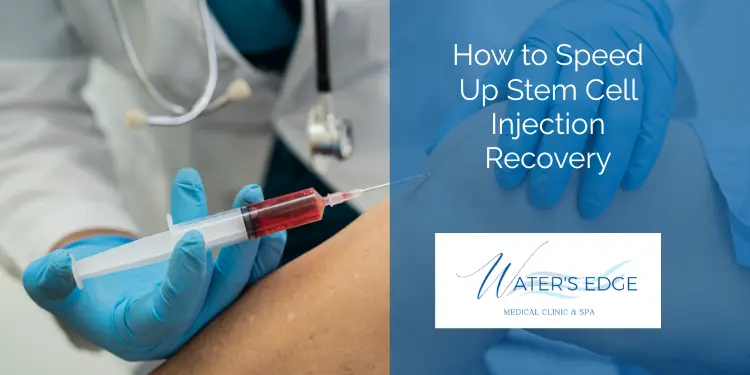So, you’ve gone through a stem cell injection, and now you’re probably wondering how to get back to feeling normal as quickly as possible. It’s totally natural to want to speed up your stem cell injection recovery process. Good news is, there are definitely things you can do to help your body heal faster and get you back to doing what you love. It’s not just about the procedure itself; what you do afterward really matters.
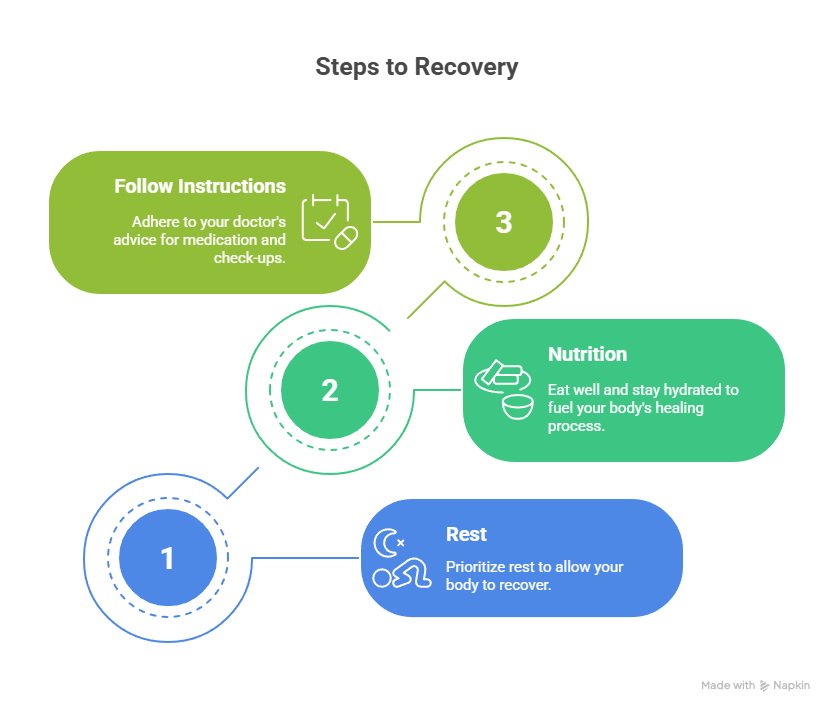
Key Takeaways
- Give your body the rest it needs right after the procedure; don’t push yourself too hard too soon.
- Eat well and stay hydrated to give your body the fuel it needs to mend itself.
- Always stick to your doctor’s instructions, whether it’s about meds or when to come back for a check-up.
Understanding the Human Cellular Tissue Allograft (Stem Cell) Injection Recovery Process
Stem cell injections are becoming more common, and understanding what to expect during recovery is important. It’s not a one-size-fits-all situation; everyone’s body reacts differently. Several factors influence stem cell injection recovery time, such as the type of injection, the area treated, and your general health.
Generally, the initial recovery phase involves managing discomfort and inflammation at the injection site. This might include rest, ice, and pain medication. The long-term recovery focuses on the stem cells integrating and promoting healing, which can take weeks or months.
It’s also important to consider stem cell treatment cost for knees and other areas, as this can influence your treatment decisions and aftercare planning.
Before undergoing this procedure, many people wonder, “Are stem cell injections safe?” While generally considered safe, it’s important to discuss potential risks and benefits with your doctor. Understanding why injecting stem cells is also key. They aim to repair damaged tissue by differentiating into specialized cells.
Here’s a general timeline of what to expect:
- First Few Days: Expect some soreness, swelling, and bruising at the injection site. Rest is crucial.
- First Few Weeks: Inflammation should gradually decrease. Follow your doctor’s instructions regarding activity levels.
- Several Months: The stem cells begin to work, and you should notice gradual improvements in your condition.
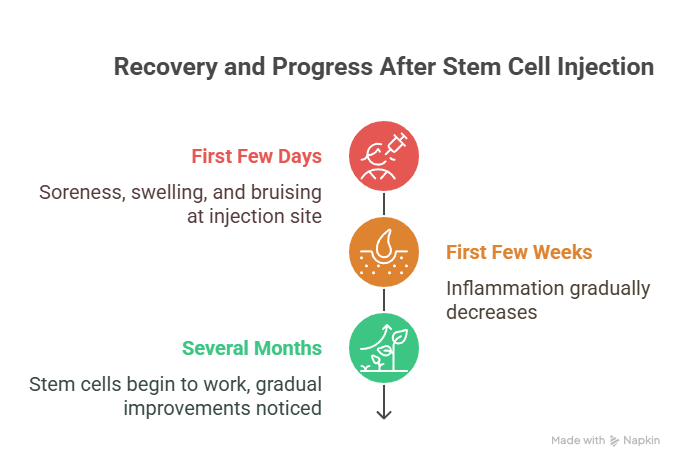
It’s important to keep all follow-up visits for your doctor to review progress and modify treatment as necessary.
Key Factors That Influence Stem Cell Injection Recovery
Okay, so you’ve gotten your stem cell injection. Now what? How effectively you heal depends on more than just the procedure itself. It’s not just about the procedure itself; it’s about your body, your lifestyle, and how well you follow post-injection advice. Let’s break down some of the big hitters.
The Specific Condition Being Treated
Some conditions just respond better to stem cell therapy than others. The severity and type of injury or disease play a huge role in determining recovery time. For example, a minor cartilage tear might heal faster than severe arthritis. Also, the location of the injection matters. Areas with better blood flow tend to heal quicker. It’s not a one-size-fits-all deal, and your doctor should give you a realistic idea of what to expect based on your specific situation.
Your Overall Health
Your general health is a major player. If you’re generally healthy, eat well, and don’t have underlying conditions, you’re likely to recover faster. Things like diabetes, autoimmune diseases, or even just being a smoker can slow things down. Think of it like this: your body needs to be in good shape to make the most of the stem cells.
The Quality of the Stem Cells
Not all stem cells are created equal. Where the stem cells come from and how they’re processed can greatly affect their results. Were they taken from your own body (autologous) or a donor (allogeneic)? How were they handled and prepared before injection? A reputable clinic will have strict protocols to ensure the cells are viable and potent. Don’t be afraid to ask about this – it’s a crucial factor.
Adherence to Post-Injection Protocols
This is where you come in! Following your doctor’s instructions after the injection is super important. This usually includes:
- Resting and avoiding strenuous activity for a certain period.
- Taking prescribed medications as directed.
- Attending follow-up appointments.
- Doing any recommended physical therapy exercises.
Ignoring these guidelines can seriously hinder your recovery. It’s like planting a seed and then forgetting to water it. You need to give the stem cells the best possible environment to do their job.
The Use of Adjunct Therapies (Like PRP)
Some clinics use additional therapies alongside stem cell injections to boost results. Platelet-rich plasma (PRP) is a common one. PRP uses a high concentration of your own platelets, injected directly into the targeted area. Growth factors in platelets help trigger tissue repair and speed up the healing process. It’s like giving the stem cells an extra nudge in the right direction. Whether or not PRP is used can definitely affect your recovery timeline.
Post-Treatment Care to Accelerate Stem Cell Injection Recovery
Okay, so you’ve had your stem cell injection. Now what? It’s not like you just walk out and everything’s magically fixed. The stem cell treatment recovery time is a real thing, and how you handle the next few weeks can seriously impact your results. Think of it like planting a seed – you can’t just toss it in the ground and expect a tree. You need to water it, give it sunlight, and protect it. Same deal here.
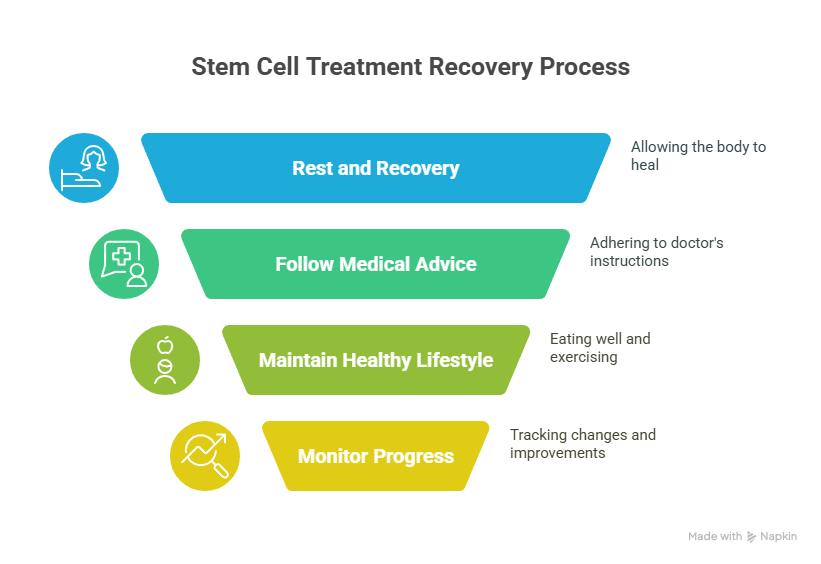
First things first, listen to your doctor. Seriously. They’re going to give you specific instructions based on your situation, and those are gold. Don’t try to be a hero and do your own thing. That’s a recipe for disaster.
Here’s a general idea of what to expect:
- Rest: Don’t go running a marathon the next day. Give your body time to heal.
- Ice: Ice is your friend. It helps with swelling and pain. Apply it for 15-20 minutes at a time, several times a day.
- Medication: Take any prescribed meds as directed. Don’t skip doses or decide you don’t need them anymore without talking to your doctor.
It’s easy to get impatient, but remember that stem cells need time to do their thing. It’s not an instant fix. Be patient, follow the instructions, and give your body the support it needs.
And speaking of support, physical therapy is often a big part of the process. It helps you regain strength and mobility. But again, don’t rush it. Your therapist will guide you on when and how to start.
One thing to keep in mind is that anti-inflammatory medications can interfere with the healing process. Your physician may recommend steering clear of them temporarily. This can be tough if you’re in pain, but it’s important for the stem cells to do their job.
Also, be realistic about how long after stem cell injections to work. It’s not an overnight miracle. It can take weeks or even months to see the full benefits. Don’t get discouraged if you don’t feel 100% right away. Just keep following the plan, and you’ll get there. The recovery time after stem cell injection varies, so patience is key.
Nutrition and Lifestyle Tips for Better Stem Cell Injection Recovery
It’s true, stem cell injections can be a game-changer, but what you do after the procedure is just as important. Think of it like this: the injection is planting the seeds, and your nutrition and lifestyle are the water and sunlight that help them grow. Let’s talk about how to make sure those seeds flourish.
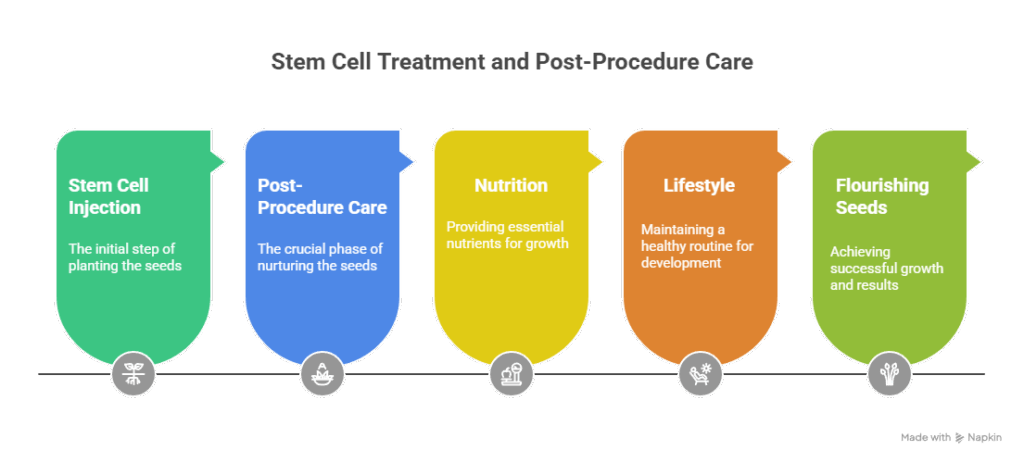
The Power of a Nutrient-Rich Diet
What you eat can seriously impact your recovery. Prioritize foods that fight inflammation and promote healing. Think lean proteins, healthy fats, and a rainbow of fruits and vegetables.
- Protein: Essential for tissue repair. Include sources like chicken, fish, beans, and lentils.
- Healthy Fats: Think avocados, nuts, seeds, and olive oil. These help reduce inflammation.
- Fruits and Vegetables: Load up on antioxidants and vitamins. Foods like berries, leafy greens, and bright vegetables support healing.
It’s a good idea to avoid processed foods, sugary drinks, and excessive alcohol. They can interfere with recovery and cause more inflammation.
Hydration is Key
Staying hydrated is super important. Drinking enough water ensures nutrients reach your cells and waste is efficiently removed. Aim to consume eight or more glasses of water each day, especially if you’re active. Herbal teas and lipovite and B12 injections can also contribute to your fluid intake.
The Importance of Rest and Sleep
Don’t underestimate the power of rest. Healing takes time, and sleep is when your body does most of its repair work. Try to get between 7 and 9 hours of restful sleep every night. Establish a calming bedtime routine to relax, and keep your bedroom dark, quiet, and cool.
Gentle Exercise and Movement
While you need rest, complete inactivity isn’t ideal either. Light exercise and gentle movement boost circulation and reduce stiffness. Check with your healthcare provider or therapist before starting any new movements, but generally, things like walking, stretching, and yoga are good options. Just be sure to listen to your body and avoid pushing yourself too hard. Remember to avoid strenuous activities for the first few days following the injections, as mentioned in stem cell therapy aftercare.
Stress Management Techniques
Stress can wreak havoc on your body, and it can definitely slow down your recovery. Incorporate stress-reducing activities like meditation, deep breaths, or nature walks into your routine. Even just a few minutes of relaxation each day can make a big difference. Try adding mindfulness exercises to your daily routine to help relax and lower stress. Keep in mind that staying calm can help speed up your recovery.
When to Seek Help During Stem Cell Injection Recovery
Okay, so you’ve had your stem cell injection. Now what? Most of the time, things go smoothly, but it’s important to know when something isn’t right. Don’t tough it out if you’re genuinely concerned. It’s always better to be safe and get checked out. Here’s a breakdown of when to reach out to your doctor.
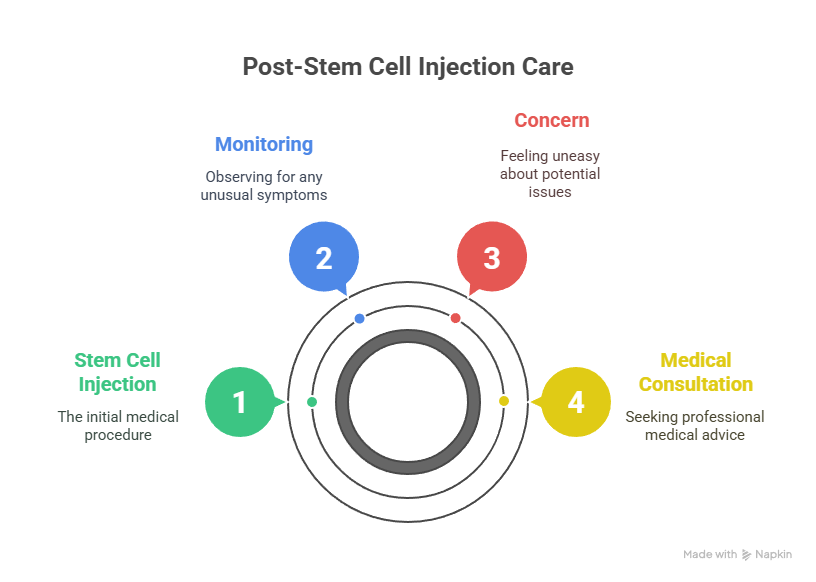
Unexpected or Severe Pain
Some pain after the injection is normal. It’s part of the healing process. But, if you experience pain that’s way worse than you expected, or if it suddenly spikes after a period of improvement, that’s a red flag. Don’t just assume it’s part of the process; get it checked out. It could indicate an infection or some other complication. It’s also important to verify that your physical therapist understands the post-op protocols.
Signs of Infection
Infection is always a risk with any injection. Keep an eye out for these signs:
- Increased redness around the injection site
- Swelling that gets progressively worse
- Pus or drainage from the injection site
- Fever
If you notice any of these, contact your doctor immediately. Quick intervention is crucial to stop infections from advancing.
Allergic Reactions
While rare, allergic reactions to stem cell injections can happen. Symptoms can range from mild to severe. Watch for:
- Hives or rash
- Itching
- Swelling of the face, lips, or tongue
- Difficulty breathing
Seek immediate emergency care if you experience breathing difficulties. Even milder reactions should be reported to your doctor.
Lack of Improvement or Worsening Symptoms
The whole point of stem cell therapy is to improve your condition. If you’re not seeing any improvement after the expected timeframe, or if your symptoms are actually getting worse, it’s time to talk to your doctor. It could mean the treatment isn’t working as expected, or there might be another underlying issue.
New or Unusual Symptoms
Pay attention to your body. If you develop any new or unusual symptoms that you didn’t have before the injection, report them to your doctor. This could include things like:
- Numbness or tingling
- Weakness
- Changes in bowel or bladder function
Remember, your doctor is your best resource. Don’t hesitate to reach out if you have any concerns, no matter how small they may seem. Early intervention can make a big difference in your recovery.
It’s normal to feel some discomfort after a stem cell injection. But if you have really bad pain, a lot of swelling, or signs of infection like fever or redness, you need to get help fast. Don’t wait! For more information or to talk to our team, you can always request a consultation on our website.
Final Thoughts on Recovery
Alright, so we’ve talked a lot about getting back on your feet after stem cell injections. It’s not always a super quick fix, but you can definitely help things along. Just remember, taking it easy, eating good food, and doing what your doctor tells you are really big deals. Your body needs all the help it can get to mend itself. Everyone’s recovery path is a little unique, so always make sure to talk with your healthcare provider about what works best for you. The whole point is to get you feeling better and back to doing the stuff you enjoy. With a bit of time and the right approach, you’ll be there.
Frequently Asked Questions

What exactly are stem cell shots and how do they help my body?
Stem cell shots use special cells from your own body. Like blank canvases, these cells can develop into bone, muscle, or other necessary tissues. When they’re put into an injured area, they help rebuild and fix what’s broken, making your body heal itself in a natural way.
What can I do to recover more quickly after getting stem cell injections?
To speed up your healing, it’s really important to follow your doctor’s advice. This usually means getting plenty of rest, not doing tough physical activities right away, and using ice if there’s swelling. Eating healthy foods and taking any medicines your doctor gives you are also key. Sometimes, extra treatments like PRP (platelet-rich plasma) shots can be used with stem cells to boost healing even more. Keep all scheduled follow-ups to allow your doctor to evaluate your healing.
What kind of feelings or changes should I expect right after the stem cell treatment?
Right after your stem cell treatment, it’s common to feel some soreness or see a bit of swelling where you got the shot. Don’t worry, this is usually a normal part of the healing process. It means your body is starting to work. Your body sends special cells to the area to begin repairing the damage. The discomfort should slowly get better as the days go by. If you have any strong pain or concerns, always tell your doctor.
If you have any additional questions or if you would like to know if stem cell therapy is right for you feel free to contact us at Waters Edge Medical Clinic, 727-550-0855.

